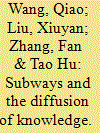| Srl | Item |
| 1 |
ID:
148694


|
|
|
|
|
| Summary/Abstract |
China, as an important source country in the global value chain, especially in the East Asian production networks, has exerted significant influence on Sino–Japanese trade fluctuations. This paper explores the real factors that lead to the fluctuations in Sino–Japanese trade. Using the Hodrick–Prescott filter technique and OECD–WTO Statistics on Trade in Value Added from 1995 to 2011, the impact of the changing comparative advantage between the two countries is also examined. The empirical results indicate that determinants of the fluctuations in Sino–Japapese trade include changing comparative advantages, the volatility of the real exchange rate and quite a few external shocks. Some policy suggestions are put forward in regards to the stability of trade between the two countries.
|
|
|
|
|
|
|
|
|
|
|
|
|
|
|
|
| 2 |
ID:
186951


|
|
|
|
|
| Summary/Abstract |
This paper aims to examine the role of the subway network, a typical form of transportation within urban areas, on innovation and knowledge diffusion. Applying the difference-in-differences strategy and spatial analysis, we used 1,332 newly opened stations in China from 2000 to 2013 as a quasi-experiment to identify the local effects of subway expansions. Results suggested that by reducing communication costs and increasing opportunities for interaction, subway construction would bring growth at the district level. Knowledge dissemination would become more active after new stations open. Micro-level results showed that these positive impacts were highly localized; that is, only those firms located within 1km around stations benefited from the new subway. Moreover, new subways facilitated the flow of knowledge from station to station and assisted firms in acquiring knowledge from more distant technology clusters conveniently.
|
|
|
|
|
|
|
|
|
|
|
|
|
|
|
|